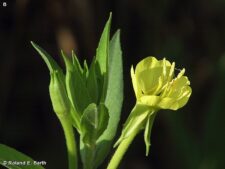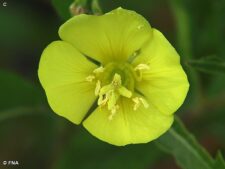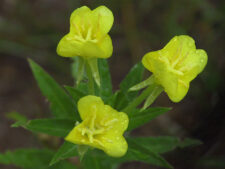
COMMON EVENING PRIMROSE
Oenothera biennis
EVENING PRIMROSE FAMILY (Onagraceae)
 Identification
Identification
- Flowering time - June, July, August, September
- Uncommon in disturbed sites at both FF and NW
- Large yellow flowers with 4 broad, slightly notched petals
- 4-parted, cross-shaped stigma at center of flower
- Tubular seed capsules up to 1 1/2 inches long
This native biennial plant produces a rosette of leaves the first year and a stout flowering stalk up to 5 feet tall the second. The leaves are lance-shaped and alternate on the stem (A). The showy yellow flowers are up to 2 inches across, emerging from leaf axils near the top of the stem (A,B). Individual flowers have 4 broad, slightly notched petals with 8 yellow stamens and a 4-parted cross-shaped stigma in the center (C,E). Only a few flowers open each afternoon; they only stay open until the next morning. Flowers are pollinated by moths at night and by bees in the early morning. The green tubular seed capsules up to 1 1/2 inches long are appressed to the stalk (D). At maturity they turn brown, often persisting through the winter.
Grows in open areas along roads and ditches and other disturbed sites. Flowering occurs from June through September. It is uncommon in disturbed areas at both Fontenelle Forest and Neale Woods.
Other common names include Night Willow-herb, Evening Star and Rampion. Less used common names like King’s Cure-All and Fever-Plant likely derive from use of its oils in traditional medicine.
The content of NatureSearch is provided by dedicated volunteer Naturalists of Fontenelle Forest who strive to provide the most accurate information available. Contributors of the images retain their copyrights. The point of contact for this page is: Roland Barth.




